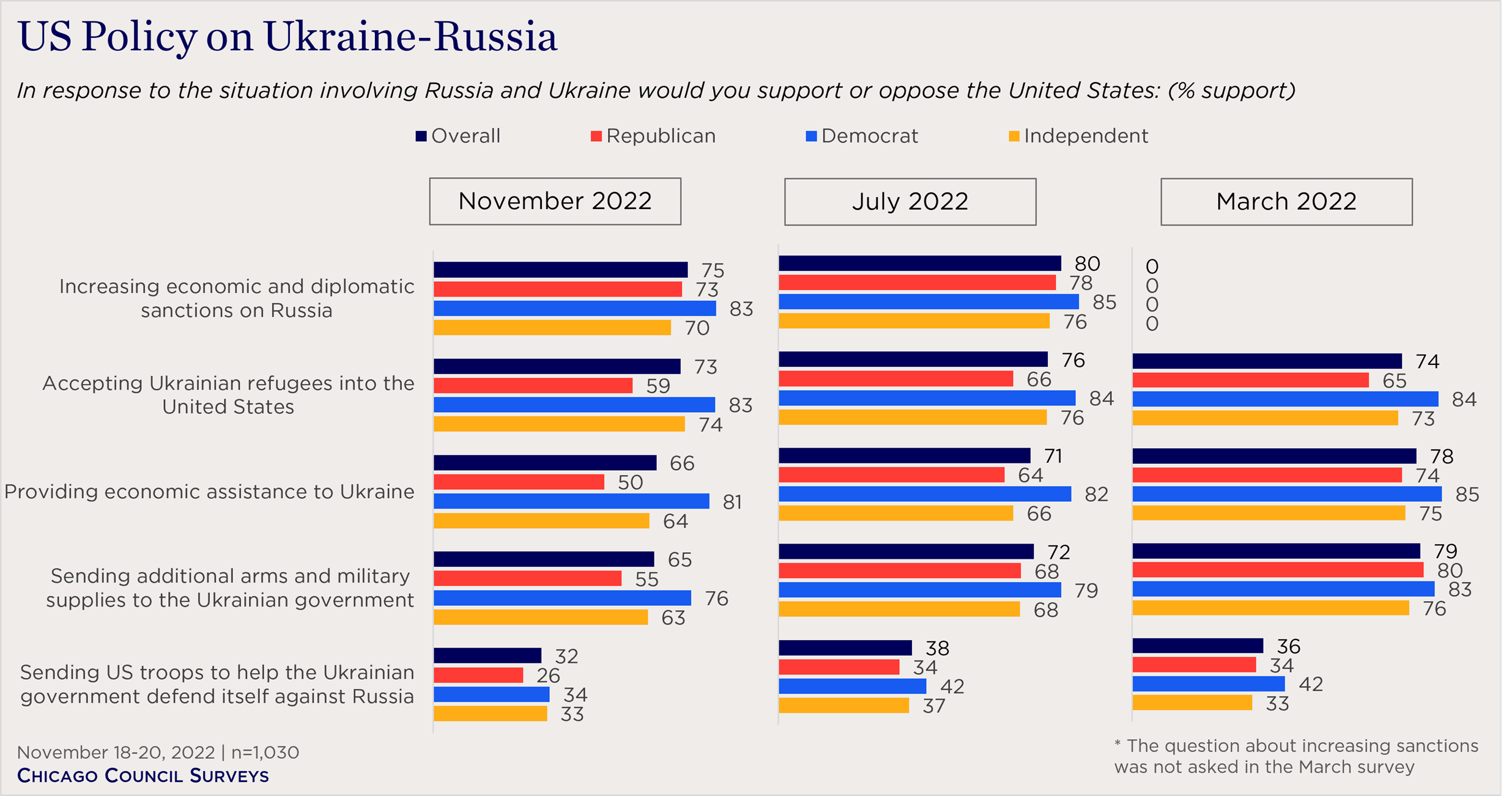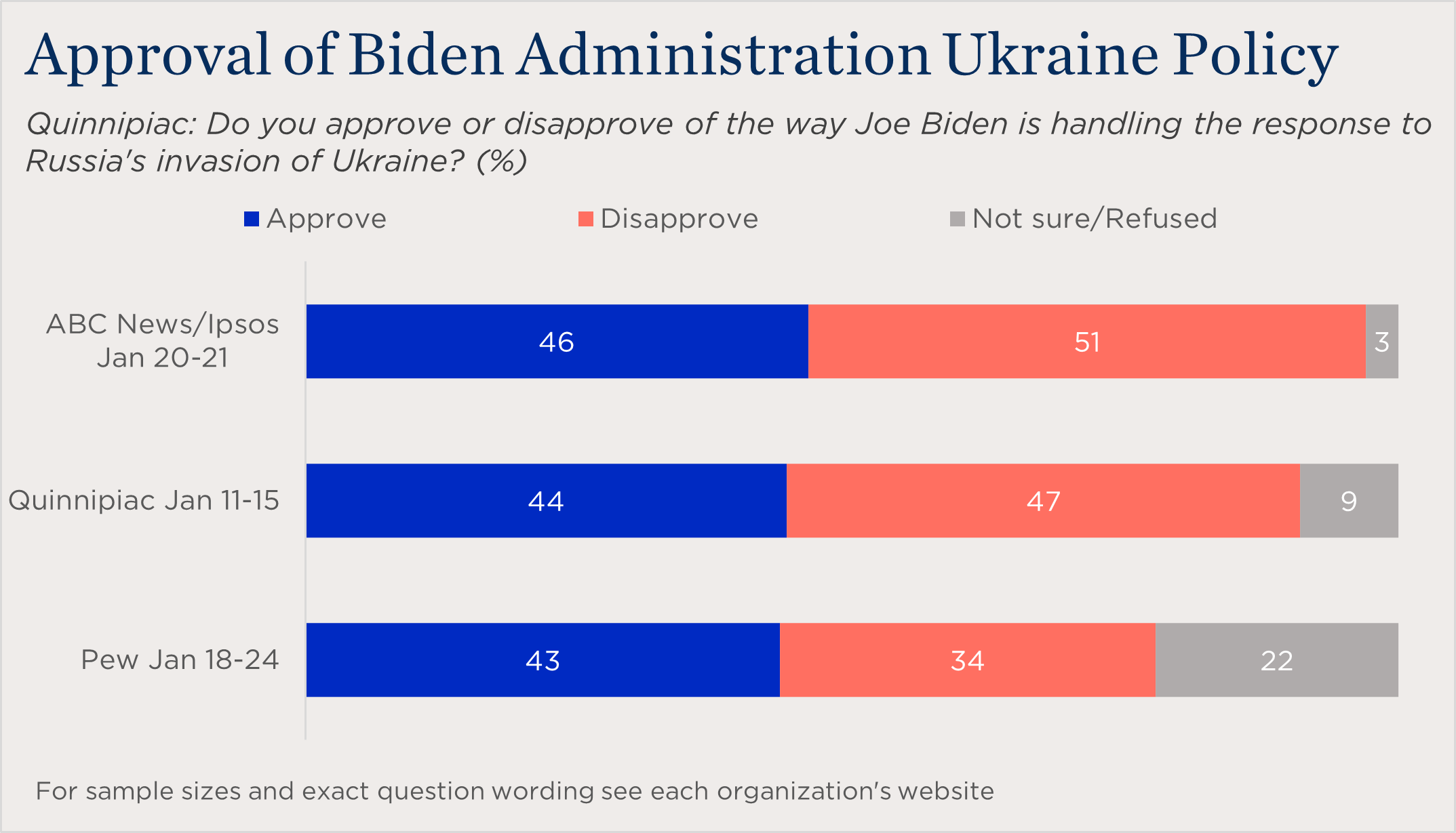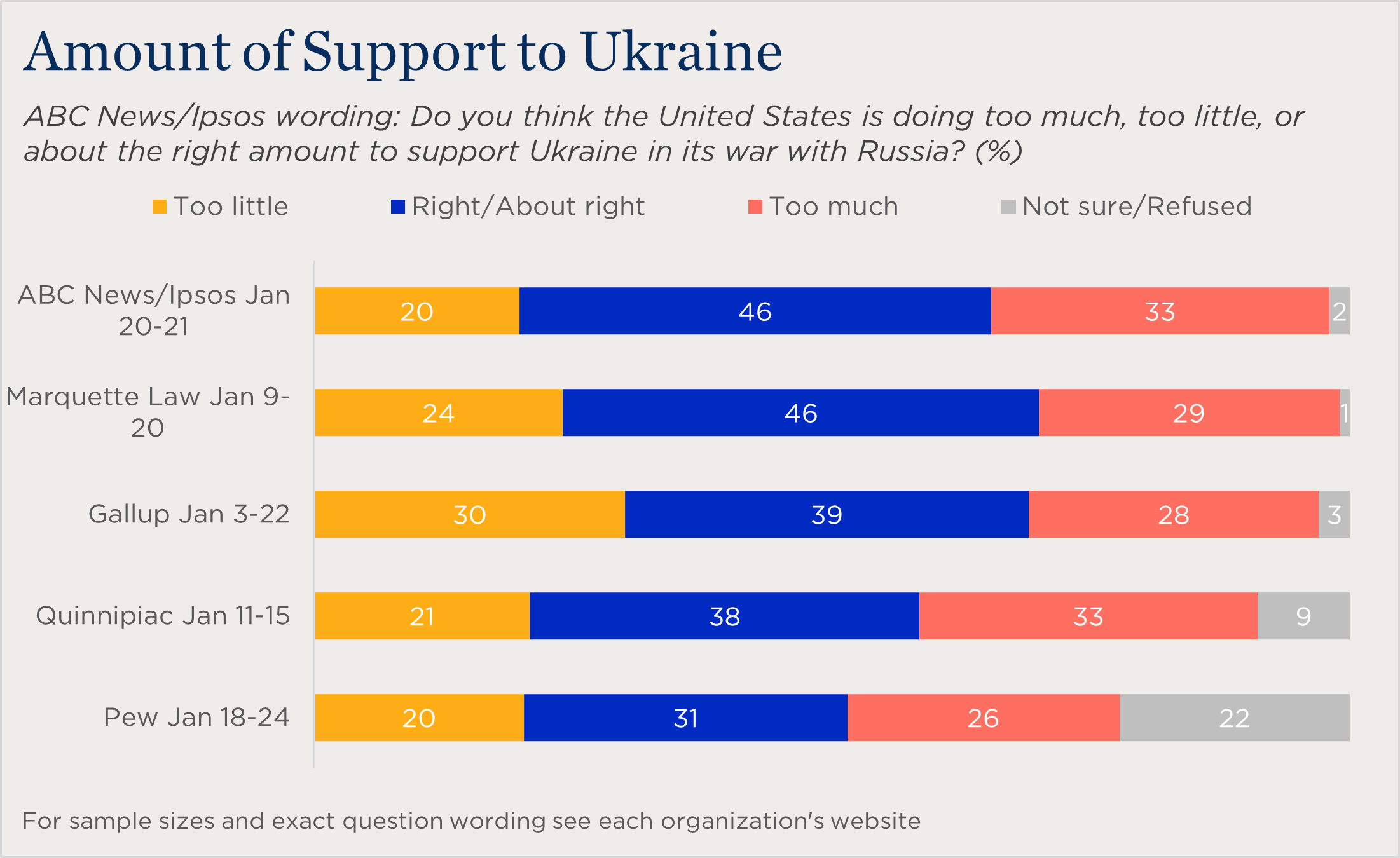A majority of the US public continues to back current military and financial aid to Kyiv, recent polls find.
The war in Ukraine is about to enter its second year, with rumors of a new Russian offensive being planned to mark the occasion. At the same time, US headlines have warned that some congressional support for US aid to Ukraine may be sliding, and several polls have shown that American public support for continuing to assist Ukraine “for as long as it takes” has slipped from the very high levels seen at the outset of the conflict. But these analyses often overlook the fact that Americans are still paying attention to the conflict one year into it, and their support for current military and financial aid to Kyiv remains at majority levels.
Key Findings
- A majority of Americans support continued military and economic aid to Ukraine and favor maintaining or increasing sanctions on Russia.
- When Americans are asked about the Biden administration’s handling of Ukraine, attitudes are more divided along partisan lines.
- Republican support for aid to Ukraine has declined more than support among Democrats or Independents. While a plurality of Americans say the United States is helping Ukraine the right amount, most Republicans now say the current level of support is too much.
Basic Support for Existing Ukraine Aid Policies
In his recent State of the Union address, President Joe Biden was crystal clear about US government support for Ukraine, speaking directly to the Ukrainian ambassador to the United States as he declared, “America is united in our support for your country. We will stand with you as long as it takes.” At present, bipartisan majorities in Congress continue to back aid to Ukraine even though a few Republican members voted against the most recent aid package. Recent polls from the Chicago Council on Global Affairs, Gallup, Fox News, and the Pew Research Center indicate Americans currently endorse a number of policies to aid Ukraine, but they are more divided when it comes to supporting Ukraine for “as long as it takes.”
A November 18–20 Chicago Council survey found that strong majorities of Democrats and Independents, and at least half of Republicans, continue to support providing economic assistance and military supplies to Ukraine, increasing sanctions on Russia, and accepting Ukrainian refugees. Among Democrats, support for these policies has remained remarkably steady over the last year. But support among Republicans—and to a lesser extent Independents—has decreased steadily between the Council’s March, July, and November rounds of polling. A January 27–30 Fox News poll of registered voters also found majority-level support among registered Democrats, Republicans, and Independents for continuing to supply Ukraine with both weapons (55% R, 79% D, 56% I) and financial aid (51% R, 79% D, 55% I). Fox found that overall support for these policies was relatively unchanged from June 2022.

While overall support for many of these policies has remained strong through the first year of the war, there is mixed evidence as to whether the American public is prepared to support Ukraine indefinitely until Kyiv is able to defeat Russia. A January 3–22 Gallup poll finds that two-thirds of Americans (65%) would prefer that the United States support Ukraine in reclaiming territory, even if this leads to prolonged conflict, while only one-third (31%) would prefer to end the conflict quickly, even if that means Russia keeps Ukrainian territory. Notably, Gallup also finds relative agreement among Republicans (53%), Democrats (81%), and Independents (59%) on their preference for supporting Ukraine.
However, the November Council poll asked Americans to consider the costs associated with supporting Ukraine and found that this prompt may decrease their support. Specifically, Americans are evenly split as to whether the United States should support Ukraine for as long as it takes, even if that means paying higher prices for gas and food as a consequence (48%), or urge Ukraine to settle for peace to avoid costs for American households, even if it means Ukraine will lose territory (47%). Taken together, these data indicate that while overall support for Ukraine tends to be bipartisan, weakening Republican support and growing sensitivity to the costs associated with aid to Ukraine are important considerations heading into the second year of the conflict.
Biden Administration Not Likely to Earn a Bipartisan Round of Applause
While many of the actual policies the Biden administration has implemented in support of Ukraine continue to receive bipartisan public support, introducing Biden’s name or any reference to his administration into a question about Ukraine has a clear polarizing effect on responses. Polls from Quinnipiac (44%), Pew (43%), and ABC News/Ipsos (46%) find approval ratings for the Biden administration’s handling of the war in Ukraine in the low to mid 40s. Results for this question tend to fall along partisan lines, with Democrats far more likely to approve of the administration’s handling of Ukraine than Republicans. On the Quinnipiac and ABC News/Ipsos polls, Biden received higher marks for his handling of the conflict in Ukraine than for his handling of any of the other policy issues asked about, such as economic issues or immigration.

Broadly, Public Says the United States Is Doing the “Right Amount”
Future developments on the front lines in Ukraine and on domestic issues in the United States (e.g., inflation) will undoubtedly impact American opinion on the conflict and support for specific policies. But for right now, the resounding finding across a number of polls is that the American public thinks the United States is doing the right amount to support Ukraine. Pluralities in recent Pew (31%), Quinnipiac (38%), Gallup (39%), ABC News/Ipsos (46%), and Marquette Law School (46%) are satisfied with the amount of aid Washington is currently providing. While most Americans are satisfied with the current level of support, most of these polls find that the remaining Americans are slightly more likely to say the United States is doing too much to support Ukraine than to say the country is doing too little. In Pew’s trend on this item, the portion of the public that believes the United States is doing too much has grown steadily over the course of the conflict.

Again here, perhaps because in part respondents are being asked to evaluate the government’s actual response rather than individual policies, partisan differences are notable. Across most of the polls referenced here, pluralities or majorities of Republicans say the United States is providing too much support to Ukraine, while pluralities or majorities of Democrats say the amount of support has been about right, and Independents are closely divided.
Americans Are Still Watching, but with Less Concern
In a time when terms like “news fatigue” have become common parlance, and even major international news stories seem to fade from headlines in days, American public attention to the war in Ukraine has remained markedly high and steady over the course of the past year. Per Pew, a majority of Americans are still following news of the invasion at least somewhat closely. And this majority remained steady from September 2022 to January 2023, after dropping off somewhat in the first six months of the war.

While Americans are still paying attention to the conflict, the sense that it poses a direct threat to the United States is waning. A March 25–28, 2022, Council poll found that 55 percent of Americans, including majorities of Democrats (67%) and Republicans (53%) considered the war in Ukraine a critical threat to the vital interests of the United States. By November, the share of the public holding that belief had declined to 37 percent. For Democrats (47%), Republicans (33%), and Independents (31%) alike, the portion of the public classifying the war in Ukraine as a critical threat had shrunk significantly. Pew surveys over the past year have yielded similar findings. While half the public (50%) classified the invasion of Ukraine as a “major threat” to US interests in March 2022, by this January that figure had declined to 35 percent.
Conclusion
With attention to the war competing with headlines about mass shootings, inflation, Chinese espionage balloons, and earthquakes, Americans are feeling less directly threatened by the war in Ukraine. While a majority are still following news about the conflict, many are starting to question how long US assistance to Kyiv can be sustained at current levels. Polls have shown that Americans are more generous in their support if they believe Ukraine has the advantage on the battlefield; a prominent victory for Kyiv would likely bolster American public support.
- Chicago Council on Global Affairs
- ABC News/Ipsos: January 20-21, 2023
- Fox News: January 27-30, 2023
- Gallup: January 3-22, 2023
- Marquette Law School: January 9-20, 2023
- Pew Research Center: January 18-24, 2023
- Quinnipiac University: January 11-15, 2023
Methodologies for the surveys cited in this piece can be found on the individual organizations’ websites using the links in the text.




Related Content
 Public Opinion
Public Opinion
Nearly half of Americans (47%) now say Washington should urge Kyiv to settle for peace as soon as possible.
 Public Opinion
Public Opinion
Consensus on how long to provide economic and military aid to Ukraine appears to be weakening as the war enters its tenth month.
 Public Opinion
Public Opinion
But those feeling an economic pinch are more likely to say that Moscow should enter peace negotiations.
 Public Opinion
Public Opinion
A slim majority think Moscow should open up negotiations, but it is unclear what they might be willing to concede.